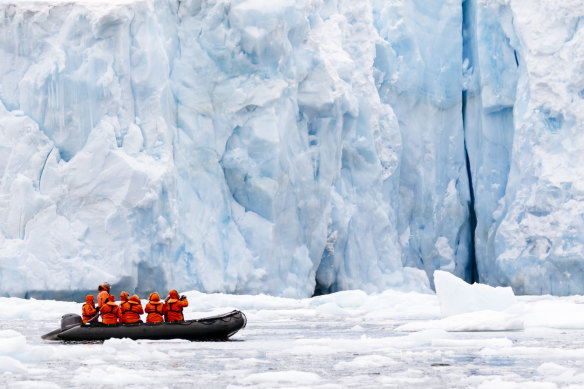Thinking of exploring breathtaking Antarctica? Everything you need to know
Sponsored by HX (Hurtigruten Expeditions)
Gone are the days when you needed to have a dog sled, seal-skin tents, and the endurance of a nineteenth-century explorer to tackle the Great White Continent.
These days, expedition ships take you to Antarctica in safety and comfort. Instead of frostbite, a frozen margarita. Instead of tinned food, a well-cooked steak and bottle of French wine.
Yet the end result remains the same: an exhilarating encounter with outsized, elemental landscapes and magnificent wildlife in the world’s last remaining great wilderness.

Explore Antarctica’s untouched wilderness.Credit: iStock
When to go?
Ice pack opens up over the Antarctic summer between November and March, when temperatures are milder and daylight hours long. January and February have the warmest temperatures, and wildlife is at its cutest: you’ll encounter fluffy penguin chicks.
However, November is best for icebergs, wildlife is active during mating season, and wildflowers bloom on sub-Antarctic islands. Don’t rule out March either, when prices are lower, and sunrises and sunsets especially spectacular.
What to pack?
Waterproof jacket and trousers, gloves and a warm hat are a must, as are insulated waterproof boots. The weather isn’t as cold as you might imagine but is unpredictable, so the key is to have multiple layers of clothing that allow you to adapt.
Think thick woollen under-layers and socks, plus thinner versions that you might wear as well. A face covering may be necessary on a windy day. What most people forget are polarised sunglasses, sunscreen and lip balm – the effects of the sun are magnified when reflected off ice and snow.
How do I get there?
Expedition cruises begin and end in one of two ports, Ushuaia in Argentina, or Punta Arenas in Chile. Both have airports with flights that connect you to international arrival cities Buenos Aires or Santiago. Consider an overnight pre- or post-cruise in order to absorb the Patagonian atmosphere of these remote cities and their surrounding landscapes.
How do I choose an expedition?
The prime destination is the Antarctic Peninsula, which features crumbling glaciers, volcanoes, mountain ranges and fields of icebergs. Count on around 11 days for a cruise.
However, if you have more time (and a bigger budget) you should consider a longer itinerary that also takes in sub-Antarctic islands such as the South Shetlands, South Georgia and the Falklands, particularly if wildlife is your main passion. These itineraries usually take between 20 and 26 days.
How do I choose the right cruise company?
Avoid large ships, which aren’t allowed to land passengers in Antarctica, or any ship with too many passengers, since only 100 people are allowed ashore at any one time.
You’ll want to sail with an experienced and reliable expedition company and, given the fragility of the Antarctic environment, one that has high operational standards and a sustainability focus.
World leading expedition company HX (Hurtigruten Expeditions) has a fleet of ships designed for polar conditions with the most sustainable footprint in the region including the world’s first hybrid-battery powered ships, with an expedition team of experts in fields such as polar history, geology, wildlife, and environmental science.
How do I explore?
There’s no typical day, since expeditions are dependent on weather and tides and might linger with the appearance of wildlife such as surfacing whales. On some days, you’ll be sailing to admire mountain scenery and icebergs, which are a particular spectacle in the Lamaire and Errera channels and Antarctic Sound.
On many days, you’ll go ashore by Zodiac to hike, snowshoe or even camp out overnight on the ice, accompanied by an expedition team with expert knowledge of the Antarctic environment and wildlife.
What animal encounters can I expect?
Antarctica offers one of the world’s most intimate wildlife encounters, since its creatures have little fear of humans. It’s more a case of trying to keep your distance than trying to get close.
Killer and humpback whales, leopard seals, elephant and fur seals, an abundance of seabirds and numerous types of penguins can be spotted everywhere, but are especially abundant in South Georgia, where penguin and seal colonies are tens of thousands strong. You’ll find the wildlife just as exhilarating as the landscapes in Antarctica.
For more information on HX expeditions to Antarctica, including all-inclusive packages with flights, contact your travel agent, call 1300 158 913 or visit hxexpeditions.com.
Sign up for the Traveller Deals newsletter
Get exclusive travel deals delivered straight to your inbox. Sign up now.